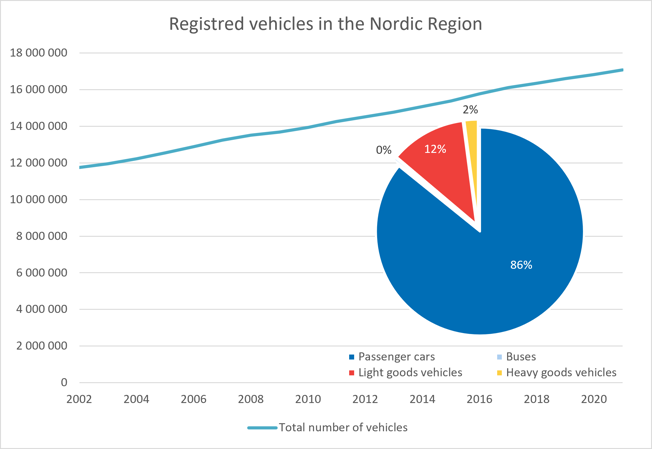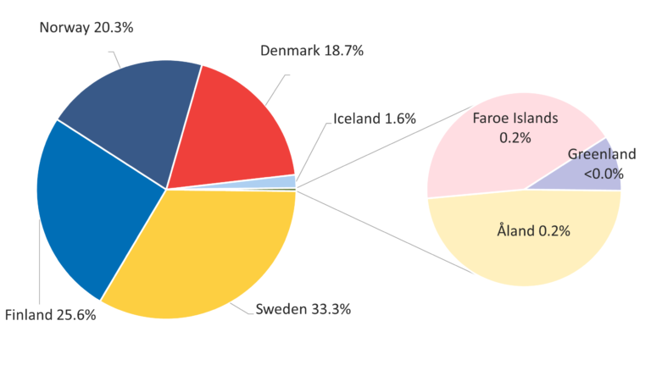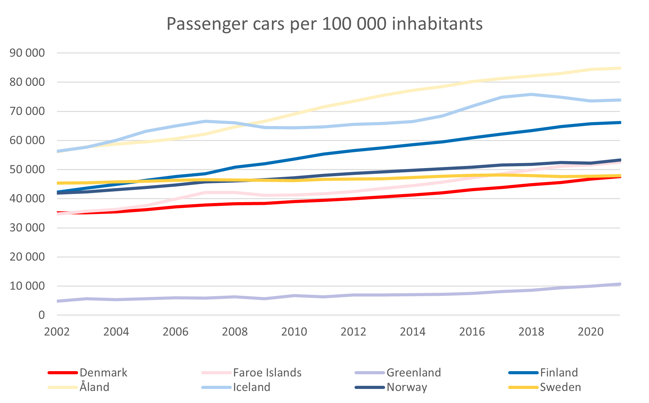The Nordic fleet of vehicles
The number of registered motor vehicles has increased by 45 percent in the Nordic region in the past 20 years. Passenger cars are the most common type of vehicle, in 2021 they accounted for 86 percent of the 17 million motor vehicles that were registered in the region. Measured in passenger cars per 100 000 inhabitants there are differences between the Nordic countries, the number varies from 10 700 in Greenland to 73 900 in Iceland.
In the past 20 years, from 2002 to 2021, the number of registered motor vehicles in the Nordic region has grown from just under 12 million to 17 million. This is an increase by 45 percent. Of the 17 million vehicles registered in 2021, 86 percent were passenger cars, twelve percent were light goods vehicles, two percent were heavy goods vehicles and less than 0.5 percent were buses. [1]

Source: Nordic Statistics Database, TRSP01: Motor vehicles registered by reporting country, vehicle and time by reporting country, unit, vehicle and time.
Of the 17 million vehicles in the region in 2021, one third were registered in Sweden. Just over 25 percent were registered in Finland, 20 percent in Norway and just under 19 percent in Denmark. In Iceland almost two percent of the total fleet was registered, while the self-governing regions had 0.4 percent of the fleet together.

Source: Nordic Statistics Database, TRSP01: Motor vehicles registered by reporting country, vehicle and time by reporting country, unit, vehicle and time.
The number of motor vehicles registered in a country is strongly correlated to the population size, especially when it comes to passenger cars. They are by far the most common type of registered vehicle in all eight countries, and the numbers have increased over time, both in absolutes and in number per 100 000 inhabitants.
Åland has the highest number of registered passenger cars in 2021, almost 85 000 per 100 000 inhabitants, followed by Iceland with 74 000 and Finland with 66 000. It is, however, important to note that the numbers for Åland and Finland includes vehicles not in traffic.
Greenland stands out as the country with the lowest number per 100 000 inhabitants, 10 700. The remaining countries are quite similar, with values between 47 000 and 53 000 per 100 000 inhabitants.
Compared to 2002 the number of registered passenger cars have increased with between six percent in Sweden and 122 percent in Greenland.

Source: Nordic Statistics Database, TRSP01: Motor vehicles registered by reporting country, vehicle and time by reporting country, unit, vehicle and time.
[1] Please note that no light or heavy goods vehicles are reported for Faroe Islands, Greenland and Iceland as no distinction between these types is available. This means that the total for these categories are slightly underestimated.